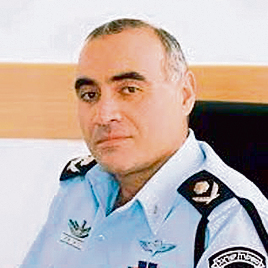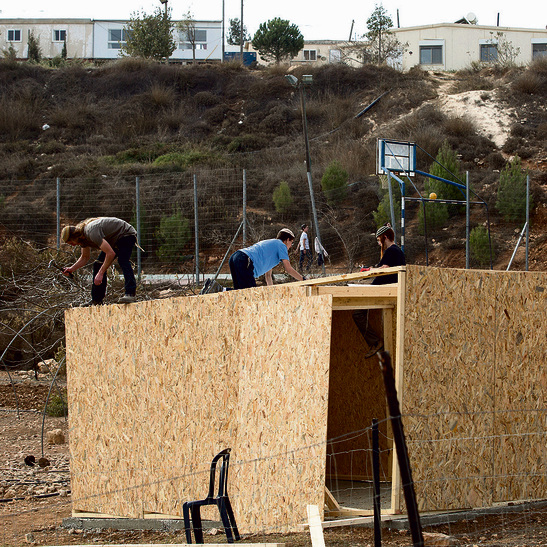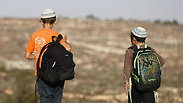
Former police commanders warn of serious violence in Amona
Brig. Gen. (res.) Meir Bokovza, Maj. Gen. (res.) Yisrael Yitzhak and former Police Commissioner Moshe Karadi recount the traumatic evacuation of the Amona outpost in 2006, hoping it won’t end the same way this time around. ‘Decision makers must understand that everyone who comes there will be prepared to fight.’
Bokovza served at the time as deputy commander of the Israel Police’s West Bank District and was tasked with commanding the operation to evacuate nine houses in Amona which were to be demolished under a High Court of Justice (HCJ) order.
At 3 am, hundreds of police officers began heading on foot to the outpost from a nearby military base. He remembers a cold but dry winter night, a wind which infiltrated through the warm clothing and shook the bones until the cold was replaced with the sweat from the walking that stuck to the clothes.
Bokovza led the force as the commander of the mission. At around 4 am, they arrived at the foot of Amona, on the road leading to the outpost. It was a dark night, and the lights of settlers’ homes glowed from up the hill. Suddenly, the police officers were struck by a barrage of stones.
“It was a planned ambush,” Bokovza recounts. “Luckily, a few moments earlier we took off our helmet glasses and were preparing to go up with the stiff plastic anti-riot gear. On the road, we encountered improvised barriers and piles of rocks. They had poured oil and tar there to make it difficult for our vehicles to drive up. One of the horses was stabbed by a person protesting the evacuation and began running wild. The mounted policeman who was on it had a hard time calming it down.
“There were policemen whose helmets’ protective glasses were smashed by stones. Commander Gideon Mor of the Border Police, who was one of the force commanders, was hit by a stone that infiltrated his helmet and broke his nose. And it all happened in the dark, when one can’t see more than a few meters ahead. I ordered the police officers not to start chasing every stone thrower – I was afraid the force would fall apart – but to carry on with the mission, which was to reach the top, Amona, in an organized row.
“Suddenly, then-MK Arieh Eldad came out of nowhere and wanted to know who was the commander. He was sent over to me. He said the HCJ had just issued an order to stop the evacuation until a discussion which would be held first thing in the morning. I checked it out with the commanders on the two-way radio and understood that it was true. I instructed the forces to come down and wait. It was the preview of the violence we encountered at the outpost five hours later. What happened there can never be forgotten, and I have definitely not forgotten. I don’t know if Amona will eventually be evacuated again, but if it is evacuated, I don’t envy those tasked with this mission.”
The numbers of that violent evacuation must be put on the table: Some 1,600 police officers were allotted to the original task force, in addition to 1,200 police officers as an operational reserve. They were faced by some 3,000 protestors of the evacuation, mostly young motivated men and women who were adamant to prevent the sights of the Gush Katif evacuation several months earlier, in which residents left their homes without any violent resistance.
The stone barrages broke dozens of helmets and riot shields. This resistance left 216 people wounded, mostly civilians. Dozens of them ended up with broken hands and feet. Forty Magen David Adom and IDF ambulances travelled back and forth, evacuating the injured. Some were evacuated on Israel Air Force helicopters.
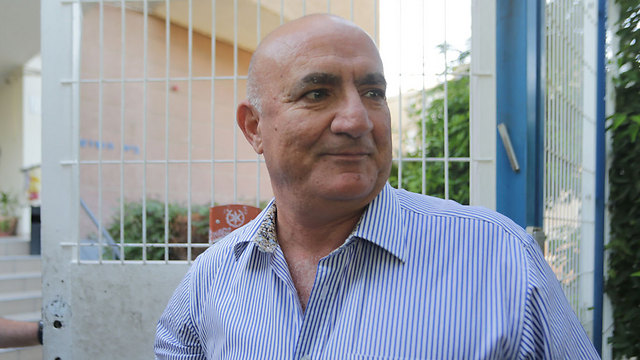
The brawl on the hill lasted more than seven hours. Everyone who was present at Amona that day spoke about a war, and all because of nine homes which the HCJ had ordered the demolition of. The rest of the homes in Amona, 40 in total, remained in place. They are transportable homes, which are very easy to demolish. But unlike the houses that were destroyed at the time, which were built in two rows and were all in the same compound, today Amona’s 40 houses are scattered across the entire hill with a few dozen meters separating between them, and that is going to make it very difficult to evacuate them.
Between Sarona and Amona
The HCJ has set December 25 as the last date for the evacuation of Amona. The Regulation Bill which is still facing political hurdles, and the alternative proposals which have been rejected – for now, at least – by the outpost’s residents, leave the countdown unchanged.
Last Tuesday, dozens of young people were busy building structures for the thousands of protestors expected to arrive at the hill if the evacuation is executed. There were wooden boards and logs in almost every corner, alongside tools and nails, screws and screwdrivers which turned the place into a busy construction site. The construction will continue till the very last minute, and the residents’ slogan appears on a sticker stuck on the rear side of the vehicles travelling up and down the hill: “Amona will not fall again!”
At the time, like today, army and police officials hoped the problem would be solved through dialogue, through a certain compromise which would lead to a quiet and organized evacuation. Senior Yesha Council officials approached the Central Command with an idea to saw the foundations of the homes and move them to other parts of the hill. They were inspired by the preservation project conducted at the Sarona compound in Tel Aviv, in which entire Templar homes were moved several dozen meters each.
“The army brought experts to look into the feasibility of this idea,” says a former senior defense establishment official, “and they determined that, as opposed to Sarona, it would be impossible to do such a thing in Amona. First of all, because the houses would fall apart. Second, because of the outline of the ground which prevents displacement. The defense establishment really wanted to avoid a conflict with the evictees and their supporters, because it estimated that such an encounter would be a difficult and violent one.”
Following the serious violence during the evacuation, both on the protestor's part and on the police’s part, the Knesset appointed a parliamentary commission of inquiry into the Amona events, led by Minister Yuval Steinitz, who was at the time an MK and member of the Knesset’s Foreign Affairs and Defense Committee, and directed by Brig. Gen. (res.) Avriel Bar-Yosef, who later became deputy head of the National Security Council and has been questioned recently on suspicion of bribery offenses. His name has also been mentioned in the submarine purchase affair. The commission of inquiry interviewed protestors who were hit by police truncheons and kicked by horses, as well as the senior military and police officials who were responsible for the evacuation operation.
Then-IDF Chief of Staff Dan Halutz briefed the committee on the division of responsibility in events involving the evacuation of illegal construction or illegal outposts: “The police work in the internal circle and the IDF provides the circumferential defense, the envelope. The army is the responsible authority in the area and is fully responsible for carrying out the mission.”
He said in his testimony that the police’s operation plan was submitted to his approval on January 23, a week before the evacuation date. It was decided that the operation’s command post would be located in the Air Force’s aerial control unit base in Tall Asur, about a two-kilometer walk from Amona, and that the army would erect roadblocks to prevent protestors from arriving for the evacuation. But when the commission members asked the chief of staff about the exact location of the roadblocks, he was unable to answer the question.
A telephone evaluation of the situation
Ahead of the evacuation, it was decided not to close off Road 60, which leads to the settlement of Ofra and to the access road to Amona. When the chief of staff was asked why the road was kept open, he replied: “Blocking Road 60 means blocking a major lifeline in Judea and Samaria. We wanted to avoid that.” The roadblocks erected by the army on the eve of the evacuation turned out to be ineffective as well: “There were clashes at the points where the barriers were placed. Soldiers were beaten by young people trying to reach the outpost,” Halutz recounted.
The commission members asked him whether the army had received any intelligence about the expected resistance during the occupation. “People sitting in my office made it perfectly clear to me that Amona would not be Gush Katif,” he answered. “There is a constant dialogue both on the command level and on the division level, as well as on the General Staff level, with the Yesha Council, with the settlers. There is a constant dialogue. There was no need to go very far. It was enough to travel, and I travel in Judea and Samaria quite a lot, and see the signs calling on people to come to Amona. What more does one need to read? That there will be a war there. That’s what it means, more or less, that there will be a ware there.”
Halutz’s testimony was followed by the testimony of then-Police Commissioner Moshe Karadi, who briefed the commission on the police’s preparations for the evacuation operation. According to his testimony, the police appointed a control command for the operation, led by Bokovza, about a month before the evacuation. The command was subject to then-Judea and Samaria Division Commander Brig. Gen. Yair Golan (who is today a major general and serves as deputy chief of staff) and to then-Judea and Samaria District Police Commander Yisrael Yitzhak. The command was in charge of three task forces comprised of Border Police regiments and the police and Border Police's special patrol forces. Eighty-nine police officers were wounded during the violent evacuation.
Asked about the police’s early evaluation of the expected level of violence, Karadi replied: “The general atmosphere was filled with determination to oppose the expected evacuation. We estimated that there would be resistance, even violent resistance, but I must admit that we did not anticipate the intensity of the violence.”
Bokovza, who is a police pensioner today, recounted the preparations last week: “We began the administrative work. Patrolling the area, receiving information and then planning – how to get there, how to organize the forces, what threats will we face, etc. The plans were approved by the division commander and the Central Command chief, Yair Naveh.
“We had to train a large amount of police officers for this operation, and the police did not have a suitable training facility, so the army gave us the Central Command’s training base in Beit Guvrin. We received special patrol officers from the Border Police and the police, blue policemen, DIFS (Division of Identification and Forensic Science) investigators to document the events, and we had to unite all of them into one force which would work in coordination as one unit. We trained them to encircle houses, lift up protestors, enter houses, split into sub-forces. On the ground, each person has to know where he comes from and what his mission is. We offered the police officers and commander technical practice and mental preparation.
“We organized three main forces: The first force was supposed to move forward, clearing roadblocks and protestors in order to open an arrival route for the two other forces, the second force was supposed to encircle the nine houses slated for evacuation and demolition, and the third force’s job was to evacuate the protestors from the houses and then isolate each house until the Defense Ministry’s heavy machines arrive to destroy them.”
At 9:30 pm, on the eve of the evacuation, the police force left the training base in Lakhish on buses to the gathering area in Tall Asur. A telephone evaluation of the situation was held that same evening between then-Prime Minister Ehud Olmert, Shin Bet Director Avi Diskin, Chief of Staff Halutz and Police Commissioner Karadi. Following that conversation, Karadi decided to recruit another 1,200 police officers from all districts and station them as a reserve force in a gathering area in Mishor Adumim. They were called up at midnight, and at 5 am they were already on the buses heading to the area. That entire time, the police were receiving intelligence from Amona.
“I brought undercover detectives into the outpost that night,” then-Judea and Samaria District Commander Yisrael Yitzhak recounted last week. “They reported that there were refrigerators and all sort of junk on the roofs, and that the roofs were surrounded by concertina wires. I’m not exaggerating, that is really what the police officers found there. The detectives reported seeing spikes. Those spikes were later used to stab horses. We knew exactly what there would be there. We didn’t just allot 1,600 police officers for this operation.”
To this very day, there is still a dispute over the military order to close off the area on the eve of the evacuation. The police expected the army to declare the area a closed military zone, which would have prevented the thousands of protestors from reaching the outpost. IDF officials say they had issued a military order to close off the area, but the order itself was not presented to the parliamentary commission of inquiry, raising suspicions that such an order had never actually been issued. Karadi said last week that the police had been surprised twice that night, “both by the number of people who arrived at Amona and by the intensity of the resistance and violence.”
Didn’t you think there would be thousands of protestors there?
“The level of expectations between us and the army was that they would close off the area and isolate the scene. That didn’t happen.”
Paint and smelly liquids
Mor Ben Hamo of Jerusalem was a 17-year-old girl at the time, a student at the Ofra religious girls’ high school. She remembers the roadblock set up by the IDF at the entrance to Ofra, and how the hundreds of young people flocking to Amona simply went around them and entered the outpost. “It wasn’t a real block,” she says. “People arrived via public transportation, got off at the entrance to Ofra and walked to Amona through the mountains. My friends and I simply walked up the hill from Ofra. No one stopped or tried to stop us from getting there.
“As the evacuation drew near, I realized there was going to be violence. They were organizing what we should take up to the roof and how to entrench ourselves. When the police arrived on the horses with truncheons and helmets, it just exploded. I witnessed serious violence, clubs hitting people in the stomach, in the neck, in the legs, in all parts of the body. A horse stepped on me, and I have been afraid of horses ever since. Still, I got off lightly, with just a few bruises. I am against violence, I didn’t throw stones at the police there, and apart from sitting on the ground I didn’t do a thing, but I was able to understand the rage that came out of people that day. There was serious violence there on the police’s part. The mounted police rode their horses into groups of people.”
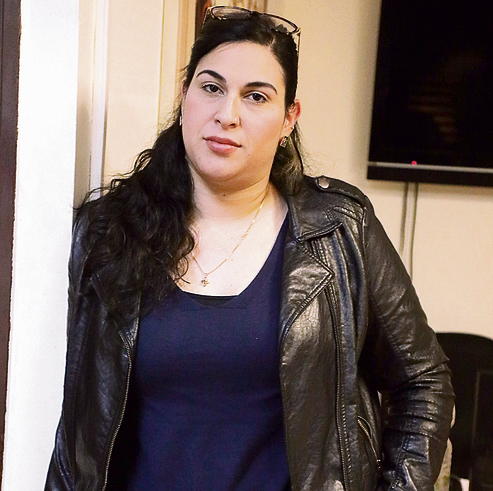
Bokovza says he came out of Amona covered in paint and smelly liquids. “Is there anything they didn’t throw at the police from the rooftops? There were tires, junk, bulbs with paint and plastic bags with all kinds of things. I had been in many riots during my service in the police, in Land Days, in the Haredi sector, in demolitions of homes in the Bedouins’ unrecognized villages in the Negev, and this was the most difficult event I had ever experienced. Taking stones, actual rocks, and throwing them at the police at point-blank range is violence at a very high level. I saw Perspex riot shields being shattered, and a Perspex riot shield is extremely durable. It doesn’t break by just being hit.”
Two weeks after the evacuation, Bokovza’s police car was torched at night in his home parking in the community of Shoham. Earlier, he had received telephone threats from people who introduced themselves as right-wing activists. Commander (res.) Yitzhak says he also experienced threats and harassment. “They came to my home and damaged my car’s mirrors and metal. They arrived with dogs at the Ashkelon home of a Border Guard officer who took part in the evacuation and attacked his son. The police district’s investigations officer at the time had his car torched too.”
Karadi, Yitzhak and Bokovza are now watching the events from afar, hoping that what happened on the Amona hill in 2006 will not repeat itself in 2016. “The decision makers must understand that there will be a war over the houses there,” Yitzhak warns. “And it’s not just those who live there, but all the people who will come from around the place. They will come to fight.”
Bokovza says the police and the army must begin their preparations as soon as possible. “I would already close off Amona to anyone who is not a resident of the area in order to prevent the arrival of protestors. And when I say close off, I mean, boulders on the paths and roadblocks with soldiers on the access roads. It’s a preparation which requires a lot of forces and a lot of patience, but if the evacuation does happen eventually, the more protestors get there the harder it will be to accomplish the mission. It’s enough to have several thousand protestors there, not resisting violently but just sitting on the ground, to prevent an evacuation.
“Do the calculation: According to the police technique, each protestor requires two to four policemen, so if there are several thousand protestors there it will force the police to bring in almost their entire order of battle, including from the offices, and that won’t happen.”
Karadi does not see a situation in which the army and the police will not be able to accomplish the mission if they have no choice. “It is unthinkable that the systems in charge of implementing a judicial ruling will not succeed in executing it. That would be a black stain on the rule of law and on Israel as a democratic state.”
He too believes that the forces must not wait for the last moment. “Who says that the 25th is a scared date and that it cannot be carried out before? Why wait for the last deadline? I hope the evacuation is carried out by consent on both sides. In any event, I hope the police and the army have begun their preparations regardless of the attempts being made to reach a compromise or a regulation. I really hope so, because this is not a simple operation.
“I have read that they are building structures for the activists who will arrive to protest, that they are preparing food and a clinic, that they are getting ready. If the police fail to prepare and end up being surprised, what happened in Amona in 2006 will repeat itself in a couple of weeks in a much more serious manner.”












